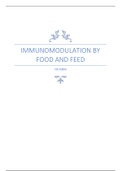IMMUNOMODULATION BY
FOOD AND FEED
CBI-50806
,Learning outcomes:
At the end of this course the student is expected to be able to:
• Define and memorize the basic aspects of immune defense reactions against
pathogens and the basis of the development of examples of immune-related
diseases.
• Define and memorize the principles of gut-associated microbiota, their physiological
functions and their major role in this defense.
• Understand the basic mechanisms of action whereby dietary components can
modulate immune function with consequences for overall health of the individual.
• Apply the theoretical knowledge acquired during the course, to be able to deal with
relevant research questions in the practical
• Apply the theoretical and practical knowledge acquired during the course to solve
real-life case-related questions.
• Critically evaluate test systems for their results and implications of the finding for the
detection of immunomodulatory activity of dietary components
Lecture 1: Introduction
,Imbalanced/improper functioning:
• Over-activity against self-antigens
o Diabetes type 1, IBD, Rheumatoid
arthritis
• Over-activity against harmless foreign
antigens
o Asthma, allergy
• Inadequate or insufficient response:
immunodeficiency
o Infections, tumor surveillance
• Chronic inflammation
o Metabolic syndrome,
neurodegenerative disorders
,Lecture: Background in immunity and
changes over life
Learning outcomes:
• Main features about innate and adaptive immune system
• Which cells are part of the innate immune system
• What is inflammation and why is it important
• What is immunomodulation and how is food or feed able to modulate
Main features about innate and adaptive immune system
Infection = non-self
Tumor = modified self
Phases of an immune response
,Recognition by germline-encoded receptors of the innate immune system and variable
antigen-specific receptors by gene segment rearrangements
Two-step immune defense
Innate immunity Adaptive antigen-specific immunity
Cells: dendritic cells, NK, neutrophils, Cells: T-cells and B-cells, macrophages,
macrophages dendritic cells
Molecules: acute phase proteins, anti- Molecules: cytokines, antibody molecules
microbial substances, chemokines,
complement enzymes
Characteristics: kinetics (fast), Characteristics: specificity, amplification,
omnipresence (present in whole body) memory, local
Innate immune recognition
Recognition of invaders: Pattern recognition receptors (PRRs)
• E.g.: Toll like receptors TLRs
o TLR2: Gram +
o TLR4: Gram -, recognizes bacterial LPS
o TLR7 recognizes RNA
o Can give the cell the signal to get activated. Response to non-self
o Can activate dendritic cells → type I interferons (IFN- & )
• Recognize ‘danger signals’ associated with a microbial attack
o PAMPs (pattern associated molecular patterns)
▪ Important to bind to cells
o MAMPs (microbe associated)
o DAMPs (danger associated, intracellular molecules): released by dying cells
PRRs recognize general characteristics of classes of invaders – not just a single invader. The
patterns they recognize represent structural features which are so important to the
pathogen that they cannot easily be altered by mutation to avoid detection.
,IL-8: chemokine
Trained immunity
• Food components first recognized by the innate immune system
o Can train the immune system
• Short ‘memory’
• Innate immunity has memory of previous infections, nonspecific response vaccines
‘trains’ existing tools, mediated by epigenetic changes
• Tolerance can also occur
o Immediately after birth
, Genetic mutations of epigenetic modifiers
o Bacteria have unmethylated DNA → transcribed
o Some food components can change methylation of DNA
Adaptive immune response
Dendritic cells: antigen-sampling cells
- Located along body surfaces that line the border of the body with the environment
o Mucosal surfaces
o GI-tract, respiratory organs, skin
- Couple innate to adaptive immunity
T-cells
- CD4+ Th cell
o Helps cytotoxic T-cells & B-cells
o Read MHC-II on APCs
- CD8+ cytotoxic cell
o Read MHC-I on tumor/virus infected cells
- Cytokines induce the differentiation from naïve t cells to different types of Th and Tr
cells.
o Specific cytokines can illustrate the Th cells
- T cells only become activated after a co-stimulatory signal and the detection of
cytokines produced by the infected cell causing cytokine production by the T cell.
Tregs: regulates, controls and modulates the T-cells
- HIV infects Tregs → disruption of T-cell system
- Anti-inflammatory: suppression of inflammation/T-cell mediated immune response
o Produces IL-10 and TGF-
- Regulate Th cells → can change balance
- Tolerance induction





